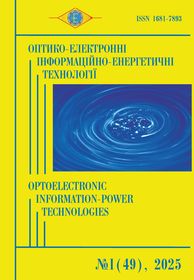Intellectual method of supporting decision making in a multi-parameter system of azimuthally invariant Mueller-polarimetric in pathologies assessment
DOI:
https://doi.org/10.31649/1681-7893-2025-49-1-200-208Keywords:
decision support, images, biological layer Muller polarimetry system, statistical analysis, wavelet analysis, decision tree methodAbstract
The article presents a method for supporting decision-making in a multiparametric system of Muller-matrix diagnostics of biological layers based on statistical and wavelet analysis of a collection of azimuthal invariants of Muller-polarimetry and decision tree models to increase the accuracy of decisions. Training decision tree models based on minimization of the Gini index for informative features of the distributions of azimuthally independent invariants of the biological layer of the cervix are developed and the accuracy of pathology detection based on them is assessed. The experimental application of the improved PPR method in the differentiation of functional states of "normal" and "pathology" of the cervical muscle tissue of the uterine cervix with the measurement of ten distributions of azimuthal invariants of the Muller-polarimetric parameters of the uterine cervix has been demonstrated. An increase in the diagnostic accuracy of uterine cervix samples to the level of 97.2% has been achieved.
References
Ghosh, N., Vitkin, I. A., “Tissue polarimetry: concepts, challenges, applications, and outlook,” J. Biomed. Opt. 16(11), 110801 (2011).
Alalia, S., Vitkin, A., “Polarized light imaging in biomedicine: emerging Mueller matrix methodologies for bulk tissue assessment,” J. Biomed. Opt. 20(6), 061104 (2015).
Lee, H. R., Li, P., Yoo, T.S. et al., “Digital histology with Mueller microscopy: how to mitigate an impact of tissue cut thickness fluctuations,” J. Biomed. Opt. 27 (7), 076004 (2019).
Ma, H., He, H., Ramella-Roman, J.C., “Mueller matrix microscopy,” Polarized Light in Biomedical Imaging and Sensing. 11, P. 281–320 (2024).
Vasyuk, V.L., Kalashnikov, A.V., Ushenko, A.G. et al., “Digital Information Methods of Polarization, Mueller-Matrix and Fluorescent Microscopy,” Springer Nature Singapore, 2023. 102 p.
Zabolotna, N.I., Sholota, V.V., Okarskyi H.H., “Methods and systems of polarization reproduction and analysis of the biological layers structure in the diagnosis of pathologies,” Proceedings of SPIE. 11369, 113691S, P. 501-513 (2020).
Khan, S., Qadir, M., Khalid, A. et al., “Characterization of cervical tissue using Mueller matrix polarimetry,” Lasers in Med Scienc. 38 (1) (2023) DOI:10.1007/s10103-023-03712-6.
Sdobnov, A., Ushenko, V.A., Trifonyuk, L. et al., “Mueller-matrix imaging polarimetry elevated by wavelet decomposition and polarization-singular processing for analysis of specific cancerous tissue pathology,” J. Biomed. Opt. 28(10), 102903 (2023).
Tumanova, K., Serra S., Madumdar, A. et al., “Mueller matrix polarization parameters correlate with local recurrence in patients with stage III colorectal cancer,” Sci Rep. 13(1), 13424 (2023).
Kim, M., Lee, H.R., Ossikovskii, R. et al., “Optical diagnosis of gastric tissue with Mueller microscopy and statistical analysis,” J. Europ. Opt. Soc. Rapid Publ. 18(2) (2022) DOI: 10.1051/jeos/2022011.
Duboazov, A., Peyvasteh, M., Tryfonyuk, M.L. et al., “Mueller-matrix-based azimuthal invariant tomography of polycrystalline structure within benign and malignant soft-tissue tumours,” Laser Physics Letters. 17(11), 115606 (2020).
Majumdar, A., Lad, J., Tumanova, K. et al., “Machine learning based local recurrence prediction in colorectal cancer using polarized light imaging,” J. Biomed. Opt. 29(15), 052915 (2024) DOI: 10.1117/1.JBO.29.5.052915.
Dong, Y. et al., “A polarization-imaging-based machine learning framework for quantitative pathological diagnosis of cervical precancerous lesions,” IEEE Trans. Med. Imaging. 40 (12). PP.3728-3738. (2021).
Qin, Z. et. al. “How convolutional neural network see the world: a survey of convolutional neural network visualization methods,” CoRR abs/1804.11191 (2018).
Luu, N. T. et al., “Characterization of Mueller matrix elements for classifying human skin cancer utilizing random forest algorithm”, J. Biomed. Opt. 2021. Vol. 26(7), 075001.
Zabolotna, N., Sholota, V., Satymbekov M. et al., “Azimuthally invariant system of Mueller-matrix polarization diagnosis of biological layers with fuzzy logical methods of decision-making,” Proceedings of SPIE 12476, 1247608. (2022) DOI: 10.1117/12.2659208/
Zabolotna, N., Sholota, V., Zhumagulova, S. et al., “System of polarization mapping and intellectual analysis of Mueller matrix invariants of biological layers in the assessment of pathologies,” Proceedings of SPIE 12985, 129850Q (2023).
Zabolotna, N.I., Sholota. V.V., “Metod ta pidsystema pidtrymky pryiniattia rishennia dlia miuller-matrychnoi lazernoi poliaryzatsiinoi diahnostyky biolohichnykh tkanyn,” Optyko-elektronni informatsiino-enerhetychni tekhnolohii 1(43) S. 43–52 (2022).
Robinson, D., Hoong, K., Kleijn, W. B. et al. “Polarimetric imaging for cervical pre-cancer screening aided by machine learning: ex vivo studies,” J. Biomed. Opt. 28(10), 102904 (2023).
Downloads
-
pdf (Українська)
Downloads: 30
Published
How to Cite
Issue
Section
License
Автори, які публікуються у цьому журналі, погоджуються з наступними умовами:- Автори залишають за собою право на авторство своєї роботи та передають журналу право першої публікації цієї роботи на умовах ліцензії Creative Commons Attribution License, котра дозволяє іншим особам вільно розповсюджувати опубліковану роботу з обов'язковим посиланням на авторів оригінальної роботи та першу публікацію роботи у цьому журналі.
- Автори мають право укладати самостійні додаткові угоди щодо неексклюзивного розповсюдження роботи у тому вигляді, в якому вона була опублікована цим журналом (наприклад, розміщувати роботу в електронному сховищі установи або публікувати у складі монографії), за умови збереження посилання на першу публікацію роботи у цьому журналі.
- Політика журналу дозволяє і заохочує розміщення авторами в мережі Інтернет (наприклад, у сховищах установ або на особистих веб-сайтах) рукопису роботи, як до подання цього рукопису до редакції, так і під час його редакційного опрацювання, оскільки це сприяє виникненню продуктивної наукової дискусії та позитивно позначається на оперативності та динаміці цитування опублікованої роботи (див. The Effect of Open Access).


